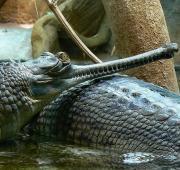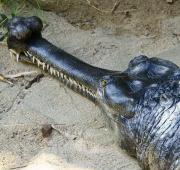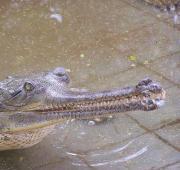 The gharial is a large-sized reptile found in the murky waters of Northern India and the surrounding countries. The gharial is closely related to other large reptiles including caimans and alligators, although the salt-water crocodile is believed to be the gharial's closest relative.
The gharial is a large-sized reptile found in the murky waters of Northern India and the surrounding countries. The gharial is closely related to other large reptiles including caimans and alligators, although the salt-water crocodile is believed to be the gharial's closest relative. The gharial is most commonly found in the calmer areas of the deep, fast-flowing rivers of the North Indian subcontinent. The gharial spends most of its time in the water as it is not well suited for a life on the land, due to its short legs.
The gharial is most commonly found in the calmer areas of the deep, fast-flowing rivers of the North Indian subcontinent. The gharial spends most of its time in the water as it is not well suited for a life on the land, due to its short legs.


The gharial is a carnivorous animal and a dominant predator within its environment. The only time that this isn't the case is when the gharial share its territory with a large salt-water crocodile. Fish is the primary food of the gharial along with insects and occasionally small animals.
Due to its large size, the gharial has no natural predators within its environment besides humans who hunt the gharial, often for leather or meat. The gharial has also been devastatingly affected by the increasingly levels of pollution in the water and is today considered to be critically endangered in the wild.
The female gharial makes their nests and lay their eggs during the dry season when the river shrinks exposing more the sand on the river banks. The female gharial lays between 30 and 50 eggs which are buried in a whole in the sand by her.
The baby gharial emerge from the underground nest after a few months and are protected in the water by their mother for a few days, until they are able to fend for themselves.

